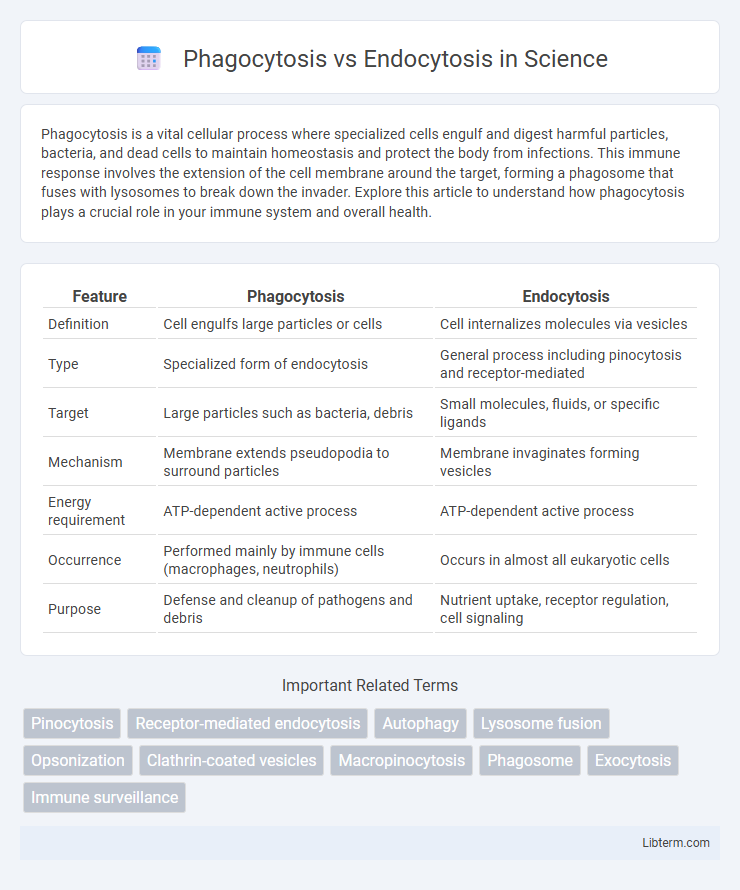Phagocytosis is a vital cellular process where specialized cells engulf and digest harmful particles, bacteria, and dead cells to maintain homeostasis and protect the body from infections. This immune response involves the extension of the cell membrane around the target, forming a phagosome that fuses with lysosomes to break down the invader. Explore this article to understand how phagocytosis plays a crucial role in your immune system and overall health.
Table of Comparison
| Feature | Phagocytosis | Endocytosis |
|---|---|---|
| Definition | Cell engulfs large particles or cells | Cell internalizes molecules via vesicles |
| Type | Specialized form of endocytosis | General process including pinocytosis and receptor-mediated |
| Target | Large particles such as bacteria, debris | Small molecules, fluids, or specific ligands |
| Mechanism | Membrane extends pseudopodia to surround particles | Membrane invaginates forming vesicles |
| Energy requirement | ATP-dependent active process | ATP-dependent active process |
| Occurrence | Performed mainly by immune cells (macrophages, neutrophils) | Occurs in almost all eukaryotic cells |
| Purpose | Defense and cleanup of pathogens and debris | Nutrient uptake, receptor regulation, cell signaling |
Introduction to Cellular Uptake Mechanisms
Phagocytosis and endocytosis are fundamental cellular uptake mechanisms crucial for transporting extracellular materials into the cell. Phagocytosis involves engulfing large particles, such as pathogens or debris, through membrane extension, primarily performed by specialized cells like macrophages. Endocytosis encompasses various pathways, including pinocytosis and receptor-mediated endocytosis, facilitating the internalization of fluids, solutes, and specific molecules via vesicle formation.
Defining Phagocytosis
Phagocytosis is a specific type of endocytosis where cells engulf large particles such as debris, pathogens, or dead cells by extending their membrane to form phagosomes. This process is primarily carried out by specialized immune cells like macrophages and neutrophils to remove harmful substances from the body. Unlike other forms of endocytosis, phagocytosis deals with solid particles rather than liquids or small molecules.
Understanding Endocytosis
Endocytosis is a cellular process where the cell membrane engulfs extracellular materials, forming vesicles to transport substances into the cell. This mechanism includes phagocytosis, pinocytosis, and receptor-mediated endocytosis, each specialized for ingesting particles, fluids, or specific molecules, respectively. Understanding endocytosis is essential for comprehending how cells regulate nutrient uptake, receptor internalization, and immune responses.
Types of Endocytosis
Phagocytosis and endocytosis are cellular processes for internalizing materials, with phagocytosis primarily engulfing large particles such as pathogens or debris, while endocytosis involves the intake of fluids, solutes, and smaller particles. Types of endocytosis include pinocytosis, which is the nonspecific uptake of extracellular fluid; receptor-mediated endocytosis, a selective process targeting specific molecules bound to receptors; and caveolae-mediated endocytosis, involving flask-shaped invaginations rich in cholesterol and sphingolipids. Each type facilitates cellular uptake for functions such as nutrient absorption, signal transduction, and membrane recycling.
Key Differences Between Phagocytosis and Endocytosis
Phagocytosis is a specific type of endocytosis focused on the engulfment of large particles or cells, such as bacteria or cellular debris, forming a phagosome. Endocytosis broadly includes various mechanisms like pinocytosis and receptor-mediated endocytosis, which involve the intake of fluids, solutes, or specific molecules via vesicle formation. The key differences lie in the particle size targeted, the cellular mechanisms involved, and the physiological roles, with phagocytosis primarily serving immune defense and endocytosis facilitating nutrient uptake and cell signaling.
Biological Significance of Phagocytosis
Phagocytosis plays a crucial role in the immune system by enabling cells, such as macrophages and neutrophils, to engulf and destroy pathogens and cellular debris. This process facilitates the clearance of harmful microorganisms and apoptotic cells, thereby maintaining tissue homeostasis and preventing infections. By activating antigen-presenting cells, phagocytosis also triggers adaptive immune responses essential for long-term immunity.
Functional Roles of Endocytosis in Cells
Endocytosis enables cells to internalize extracellular molecules, nutrients, and plasma membrane components essential for maintaining cellular homeostasis and signaling pathways. It facilitates receptor-mediated uptake, allowing precise regulation of nutrient intake and response to environmental stimuli. Phagocytosis, a specialized form of endocytosis, primarily targets large particles or pathogens, playing a critical role in immune defense and tissue remodeling.
Common Examples of Phagocytosis and Endocytosis
Phagocytosis commonly occurs when macrophages engulf bacteria or cellular debris to eliminate pathogens and maintain tissue homeostasis. Endocytosis includes processes like receptor-mediated endocytosis, where cells internalize cholesterol via low-density lipoprotein (LDL) receptors, and pinocytosis, which allows fluid and small molecules uptake. These mechanisms are essential for nutrient acquisition, immune defense, and cellular communication in multicellular organisms.
Regulatory Factors and Molecular Mechanisms
Phagocytosis and endocytosis are cellular processes regulated by distinct factors such as membrane receptors, signaling pathways, and cytoskeletal dynamics; phagocytosis primarily involves actin polymerization triggered by receptor-ligand interactions like Fc receptors and complement receptors. Endocytosis includes clathrin-mediated, caveolin-mediated, and macropinocytosis pathways, regulated by adaptor proteins (e.g., AP2), lipid composition, and GTPases like dynamin that facilitate vesicle scission. Molecular mechanisms underlying both processes involve complex coordination of membrane trafficking proteins and signaling molecules to ensure selective cargo uptake and membrane remodeling.
Comparative Summary: Phagocytosis vs Endocytosis
Phagocytosis and endocytosis are both cellular processes for internalizing substances, with phagocytosis specifically engulfing large particles such as debris or microorganisms, whereas endocytosis encompasses multiple mechanisms including pinocytosis and receptor-mediated uptake for fluids and smaller molecules. Phagocytosis involves the extension of pseudopods to surround targets, creating large vesicles called phagosomes, while endocytosis typically forms smaller vesicles from plasma membrane invagination. The key functional difference lies in phagocytosis being a form of active defense and nutrient acquisition predominantly in immune cells, contrasted with endocytosis' broader role in cellular uptake and membrane recycling across various cell types.
Phagocytosis Infographic

 libterm.com
libterm.com